Rennie Scaysbrook | December 22, 2016
Retro is king right now and the scrambler has come roaring back into our collective subconscious. It’s time to pitch them all together to see who comes out on top.
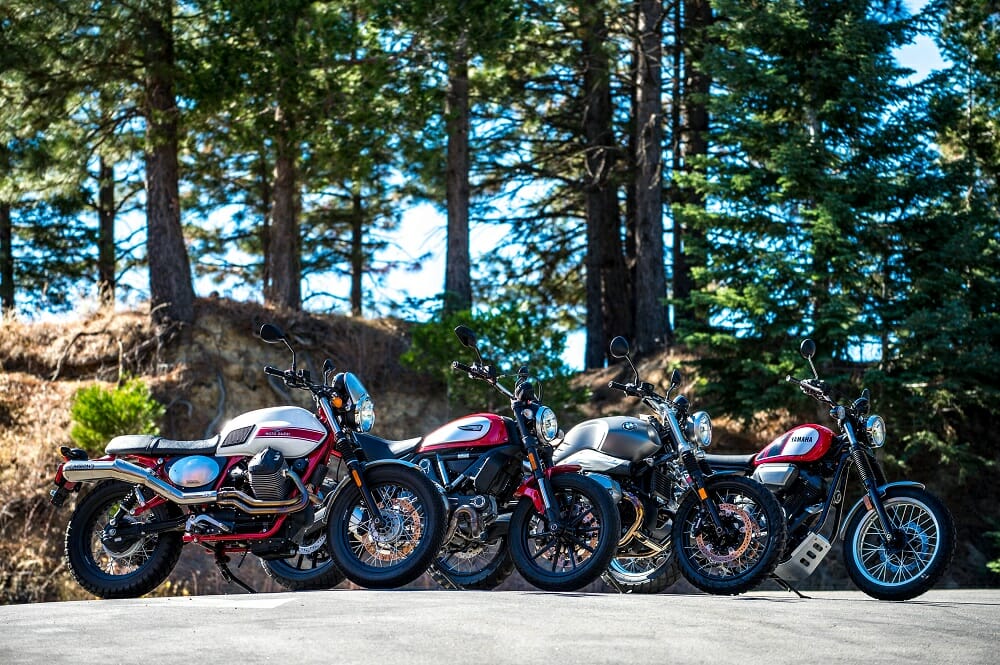 What a good-looking bunch! The scrambler segment certainly has the style factor going for it.
What a good-looking bunch! The scrambler segment certainly has the style factor going for it.
What’s old is new again.
Watching the evolution of the motorcycle industry over the past few years has been pretty bloody interesting, to say the least. As sportbikes, tourers and even cruisers have gone further and further into the future, there’s been a different group of individuals going the opposite direction, churning out custom café racers and scramblers that have about as much tech in them as a cup of tea.
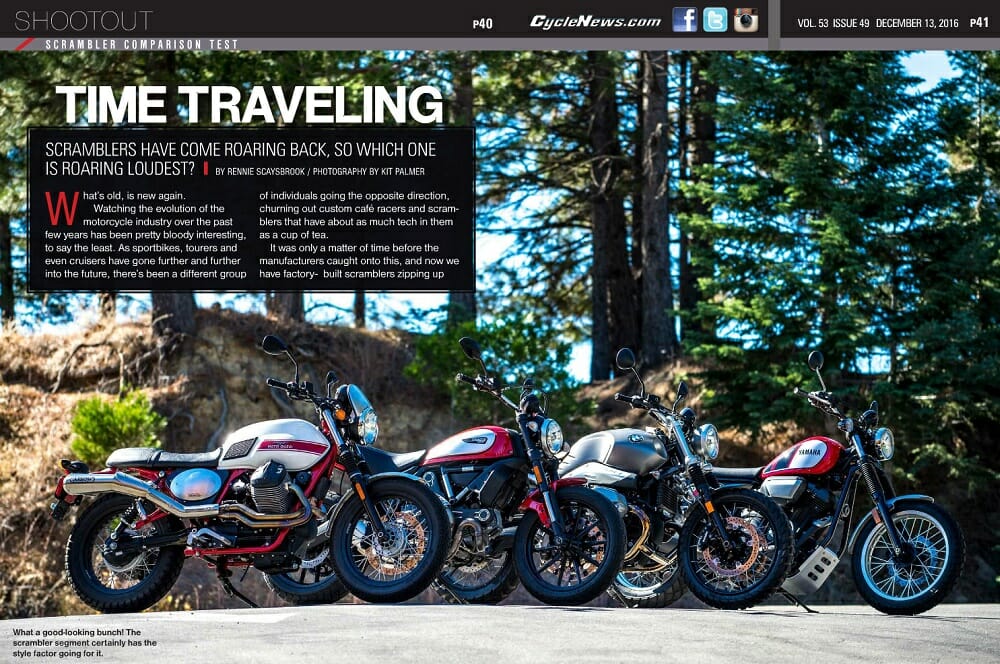
Photography by Kit Palmer
It was only a matter of time before the manufacturers caught onto this, and now we have factory-built scramblers zipping up and down our canyons and dirt roads just like when they were the real deal, nearly 50 years ago.
But what exactly is a scrambler? Do you just throw a set of off-road tires on a bike and that’s it? Well, not exactly. Scramblers, or rather scrambling, is the forefather of motocross. Before motocross was essentially its own sport, riders of the 1940s and ’50s would front the gate on the same bikes they rode to work on, mainly big British singles like Matchless, AJS and Triumph. The bike had to be a jack-of-all-trades, and riders would flat track, road race, and scramble all on the same steed. By the end of the ’60s, scrambling had given way to what we now know as real motocross, and these bikes went back to what they were originally intended to be—roadbikes—and this is from where each of these four bikes can draw their heritage.
So for our 2016 Scrambler test, we have BMW’s brand-new R nineT Scrambler, Yamaha’s equally new SCR950, Moto Guzzi’s Stornello V7 II and the bike that arguably (re)started the scrambling trend, Ducati’s Scrambler Icon. We asked Triumph to participate in this test with their Scrambler that began life way back in 2006, but they declined, as they’d just launched the Street Scrambler at EICMA and didn’t want to wheel the old model out one last time.

|
Job title: Cycle News Road Test Editor
|
Job title: Cycle News Editor
|
Job title: Co-owner of Cycle News
|
Job title: Co-owner (the good part) of Cycle News
|
|
Age: 34
|
Age: 55
|
Age: 47
|
Age: 39 still!
|
|
Experience: Riding since the age of three, racing since eight, and street riding at 16. Rides and races anything and everything as part of being Road Test Editor. Has a strange love for Vegemite. Lost a fight with the Armco fencing at Pikes Peak this year.
|
Experience: Started riding at eight; first time on a bike didn’t go well but he loved it anyway. Considers himself a dirt-bike guy, but rides on the street nearly every day. Raced MX for many years until he caught the enduro bug (then the hare & hound bug, then the hare scrambles bug…) Bottom line, if it has two wheels, he enjoys riding it.
|
Experience: Riding since his parents bought him a Honda MR50 at age five. Racing since age 14 (if you count three-wheelers and quads) but followed that up with a lot of years of motocross and off-road racing. A lot of ADV miles including two-up trips with his wife.
|
Experience: Started riding dirt bikes at five, raced his first motocross race at 17 and has been evaluating motorcycles full-time as a magazine editor since 2005. Arguably has too many ideas of what the perfect motorcycle is. Also has the cutest daughter in the world.
|
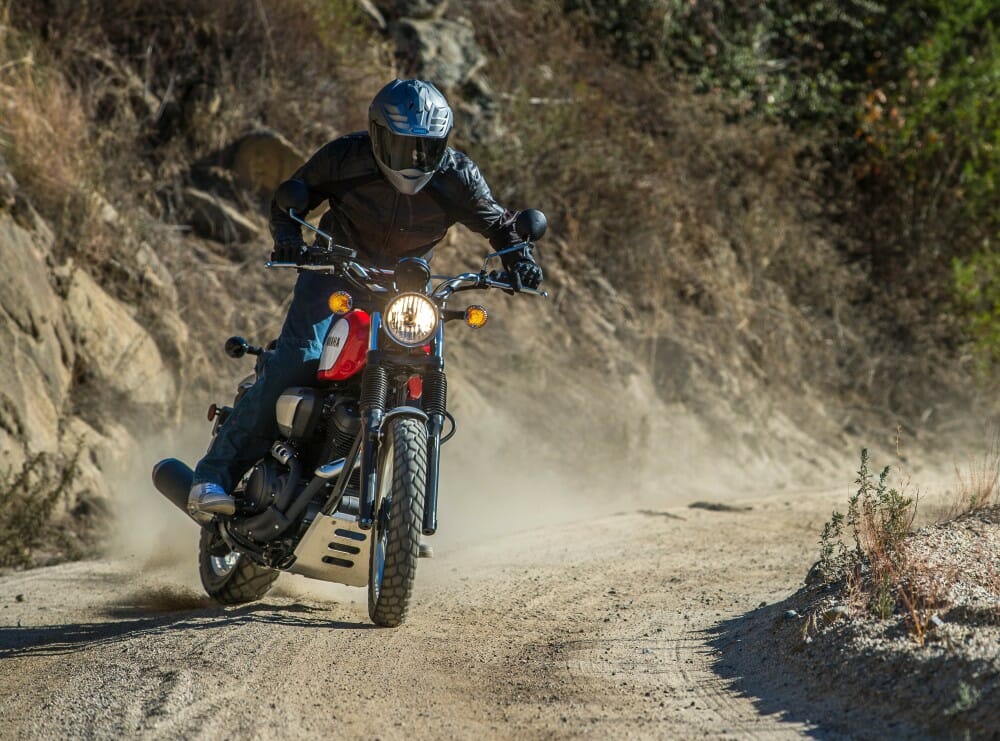 Despite its girth, the Yamaha was great fun in the dirt thanks to the low and lazy chassis.
Despite its girth, the Yamaha was great fun in the dirt thanks to the low and lazy chassis.
|
Engine:
|
942cc, air-cooled, SOHC, 4-stroke, eight-valve V-twin four-stoke
|
|
Chassis and suspension:
|
Tubular steel cradle, 41mm conventional, unadjustable forks, twin unadjustable rear shocks.
|
|
Front brakes:
|
Single 298mm discs, twin-piston calipers
|
|
Rear brakes:
|
Single 298mm disc, single-piston caliper
|
|
Front/Rear wheel sizes:
|
19 in./17 in.
|
|
Weight:
|
547 lbs. (wet, claimed)
|
|
Electronics:
|
None
|
|
MSRP:
|
$8,699
|
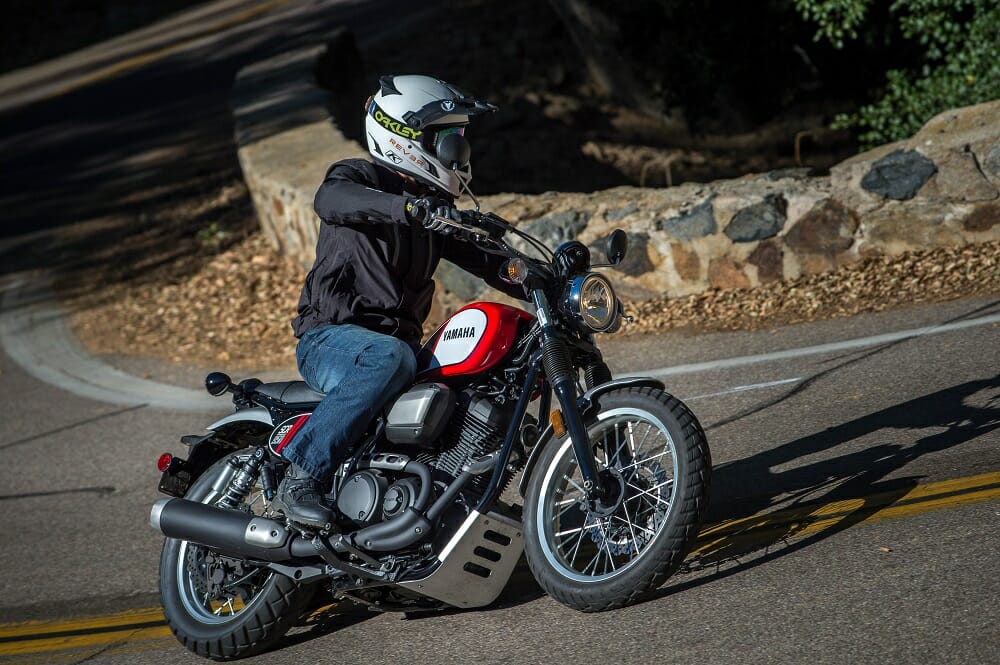 Lumpy power from the cruiser engine was a good fit for twisty mountain passes.
Lumpy power from the cruiser engine was a good fit for twisty mountain passes.
This bike is a Yamaha Bolt with different styling and bars. It’s a good basis for any custom, but when put against something like a purpose-built Ducati Scrambler, some fairly obvious issues show up.
The extra weight over the other three meant handling suffered and the ultra-wide handlebars and peg position makes you feel like a sail in the wind when you get going at any speed above 50 mph. Another area the Yamaha suffered in was ground clearance. The SCR950 would scrape its guts well before any other bike here, so it was hard to keep the pace in the canyons when chasing the BMW or Ducati, and jumping the thing or even hitting big bumps became a concern.
For reasons other to what we know, Yamaha refused to move the side cylinder-mounted air cleaner when designing the SCR. That means your right leg is always hitting it and makes for a pretty uncomfortable ride.
On the plus side, the SCR’s 942cc engine had plenty of smooth, unintimidating torque in that true cruiser fashion, and the lack of any electronics made for good times on the dirt (just watch out you don’t snap the belt final drive!). The SCR sits pretty low, so it makes for a stable bike on the dirt, easy to slide around although not the fastest steering on the road. It’s the least expensive bike here, and that’s a good thing, especially when there are so many areas that someone with even a small custom bone in his body could make some improvements on.
Aesthetically, the Yamaha looks pretty spot-on. Yamaha’s styling department got the look but sadly we couldn’t rate it any higher than fourth. ~Rennie Scaysbrook
 (Left) Bash plate is standard fitment—thanks for thinking of that, Yamaha. (Middle) The seat has plenty of space but gets pretty uncomfortable after 45 minutes. Number plates are a nice touch. (Right) Those big bars give good leverage but hurt highway comfort.
(Left) Bash plate is standard fitment—thanks for thinking of that, Yamaha. (Middle) The seat has plenty of space but gets pretty uncomfortable after 45 minutes. Number plates are a nice touch. (Right) Those big bars give good leverage but hurt highway comfort.
Jesse Ziegler As soon as you start to ride the SCR like a sportier bike, you run into cruiser bits such as the center cylinder mount air cleaner and the low pipe clearing footpeg brackets. It even has the world’s simplest steel fuel tank and quarter-turn cap. But, the motor, as a big V-twin, does provide cool low-end torque that easily pulls up steep switchback turns on mountain roads. Also, the bike is so low, you’ll scrape the under bits on nearly every corner on smaller twisty roads—so you’ll feel pretty cool that way. It’s not my favorite, but it is capable of exploring roads, and it’s priced so you can use it as a blank canvas to finish your bike how you want to.
Kit Palmer I wasn’t a fan of the SCR when I first hopped on it but this bike grew on me. It has a lot of quirks—a shifter lever that gets in its own way, terrible footpeg clearance, an airbox that cramps your right knee. It feels long and heavy, and I’m not thrilled about it being belt driven when I’m on the dirt. Oh yeah, stay away from big (okay, any) bumps with that whopping 2.8 inches of rear-wheel travel. Still, I like the way it looks and how its air-cooled V-twin motor puts the power to the ground. And I like how Yamaha didn’t even bother with ABS or traction control. It’s comfortable and spacious, and it works pretty well in the dirt, too. I like it a lot—just not quite as much as the others.
Sean Finley The Yamaha is the most unique among the bikes tested and the V-twin Cruiser roots are evident. If you are coming from a cruiser background, this would likely be the most comfortable bike to ride. The motor provides good grunt off the corners and it is stable on hard-packed gravel roads. But it is the heaviest bike here and you will feel the weight if you hit any soft dirt, and that makes it the least comfortable of these bikes off road. For me, the shifter was always in the way on my left foot and the air filter banged my knee on the right but it is otherwise comfortable to ride long distances.
Third — Moto Guzzi Stornello V7 II
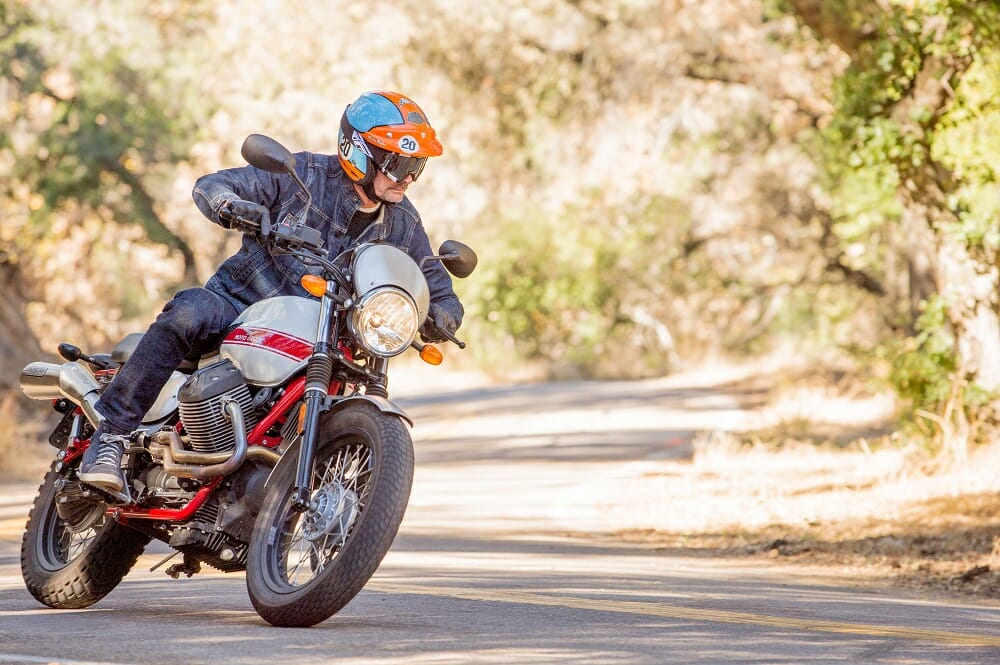 The Moto Guzzi’s on road manners are impeccable and perfect for weekend cruising.
The Moto Guzzi’s on road manners are impeccable and perfect for weekend cruising.
The Vitals – Moto Guzzi V7 II Stornello
|
Engine:
|
744cc, 90° V-twin, 8-valve four-stroke
|
|
Chassis:
|
Double cradle tubular steel frame, 40mm unadjustable fork, twin, preload-adjustable rear shocks.
|
|
Front brakes:
|
320 mm disc, Brembo four-piston caliper. ABS (can be disengaged)
|
|
Rear brakes:
|
260 mm disc, floating two-piston caliper
|
|
Front/Rear wheel sizes:
|
18 in./17 in.
|
|
Weight:
|
419 lbs (curb, claimed)
|
|
Electronics:
|
ABS, traction control
|
|
MSRP:
|
$11,190
|
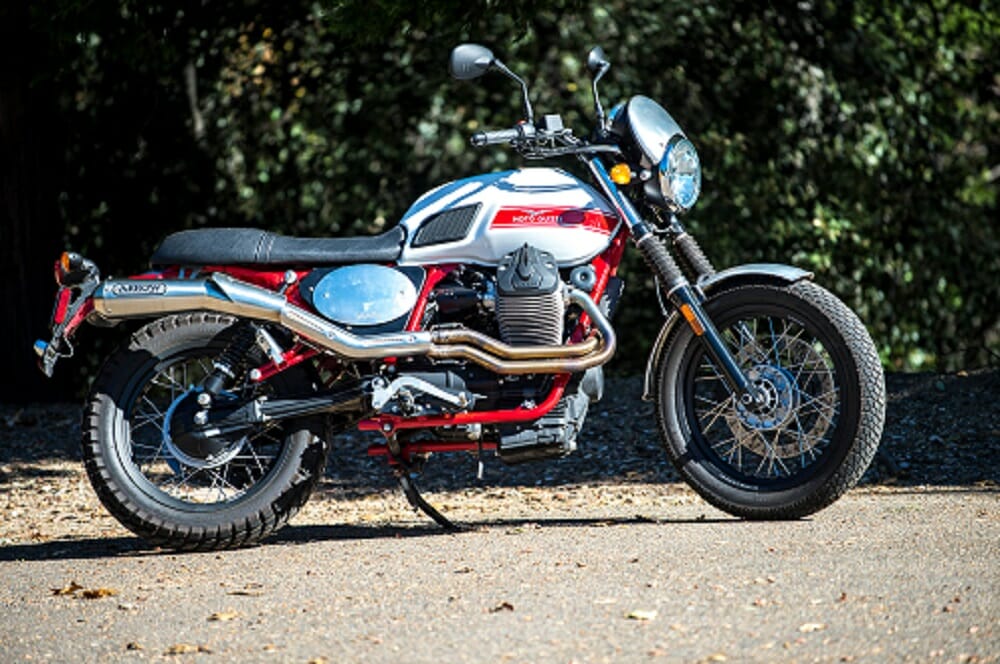 Isn’t she pretty? The Stornello is limited to only 1000 items so you better get in quick if you want one.
Isn’t she pretty? The Stornello is limited to only 1000 items so you better get in quick if you want one.
Charming. That’s the best way I can describe Moto Guzzi’s gorgeous little V7 II Stornello (by the way, we chose the Stornello because this is the only factory-built scrambler that comes from Moto Guzzi. Guzzi has a V7 Scrambler available in the U.S., but it is a kit that is special made by dealers and based on the V7 – not a machine that comes off the production line in Lake Como, Italy).
It’s lovely when a bike surprises you, even better when it surprises everyone. One look at the Stornello and, unless you’re clinically dead, you’ll find something to like about it. Beautiful design, that smashing Arrow exhaust, the transverse V-twin, excellent ergonomics and decent performance, the Stornello is, indeed, a bike that every tester here said they’d like to permanently have in their garage. And yes, we all looked at each other in shock, afterward.
The 744cc V-twin has the least power on test, but it matters not. The performance is adequate for the task, throttle response is smooth and the suspension more comfortable than the Yamaha, with a better seating position than the Ducati.
The Guzzi is rather cramped in the cockpit for off-roading with the narrowest bars that, for me, are too close to my chest, but that translates to a nice, neutral riding position for the road. And at the end of the test, with a 100-mile ride ahead of me for home, I grabbed the keys to the Guzzi without hesitation.
Another area that makes the Stornello extra cool is there will only be 1000 produced. At this stage, you’ll still be able to buy the built-up V7 Scrambler from Moto Guzzi in the U.S., but as far as factory-built scramblers go, Guzzi will only offer this model. This is one of those individualistic machines. It’s more suited to beach runs and bar hoping than outright “scrambling,” but its charm overrides most of its flaws. ~ Rennie Scaysbrook
 (Left) That Arrow exhaust looks awesome, and that seat is the best here for long distance comfort. (Right) Shaft drive. Happy days for those who hate chain maintenance.
(Left) That Arrow exhaust looks awesome, and that seat is the best here for long distance comfort. (Right) Shaft drive. Happy days for those who hate chain maintenance.
Jesse Ziegler The Moto Guzzi is a pretty cool bike. It feels old-school, with a lumpy, chunky power delivery and slammed low stance. It rolls on with a fun power delivery that can have you smiling for days, but not overly impressed. This segment isn’t as much performance as it is coolness. Here, the Guzzi has serious street cred. Additionally, you’re not going to run into many more Moto Guzzi Stornello riders on Sunday fun runs. It’s unique, super cool, torquey and fun for just the right roads these bikes shine on. It has old-school style and a nod to performance with the Arrow high-route exhaust and, well, you can put a number on it, because it has number plates! It’s comfortable, fun, a bit weird and on the right side of analog to be a class winner.
Kit Palmer When I was put in the spotlight and asked to choose my favorite, I even surprised myself when I said “Moto Guzzi.” The modern-day scrambler to me is not as much about performance as it is a feel, or a mood, like, which bike makes you grin every time you see it in your garage. For me, that bike was the Moto Guzzi. It looks pure retro, and how can you not like the looks of those mid-pipes? I was pleasantly surprised by how well the Guzzi performed, too, both on and off the road. It makes reasonable power, it’s very smooth on the highway, and it feels remarkably light and agile. And even the suspension is impressive. I would love seeing it permanently in my garage, without question.
Sean Finley The Moto Guzzi surprised me the most in this test. The seat is very roomy and plush compared to the other bikes and the relationship between the seat, pegs and handlebars is good for cruising or riding dirt roads. The handlebars are the narrowest of the bunch, which felt strange at first coming off the other bikes but felt fine once you got used to it and did not seem to hold it back on the dirt. The motor is the least inspiring among the group so if you like a burst of acceleration and rumble on your ride, the Guzzi isn’t for you. The high exhaust and overall styling on the Guzzi has an old-school look that is arguably one of the most authentic.
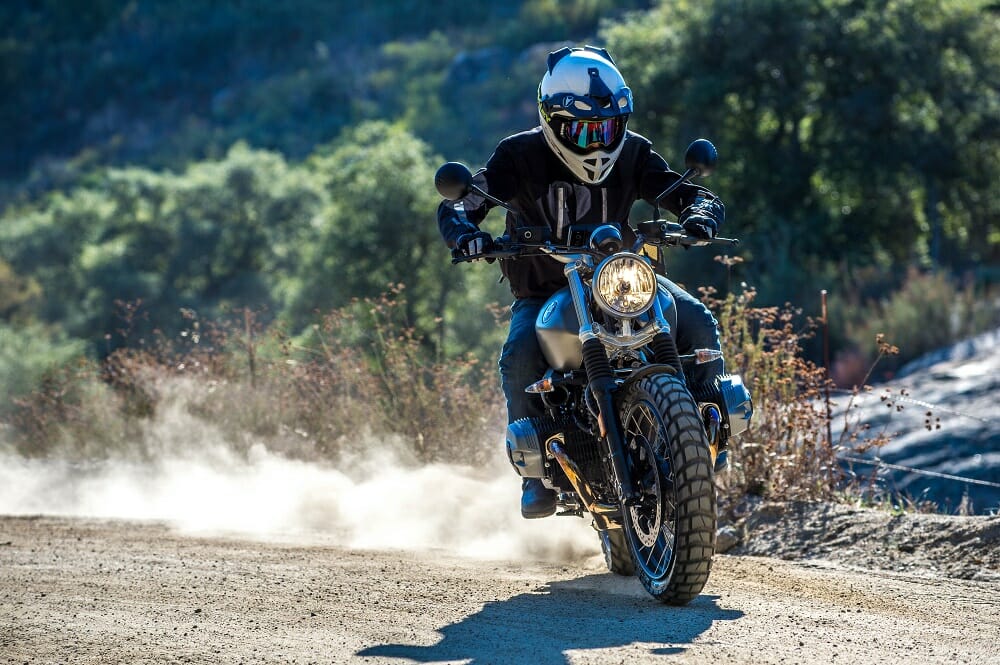 1170cc of German grunt makes light work of fire roads, plus the R nineT looks awesome when sideways!
1170cc of German grunt makes light work of fire roads, plus the R nineT looks awesome when sideways!
|
Engine:
|
1170cc, air/oil-cooled, 8-valve, twin-cylinder boxer 4-stroke
|
|
Chassis and suspension:
|
Tubular space frame in steel, engine self-supporting, 43mm unadjustable, inverted forks, unadjustable monoshock.
|
|
Front brakes:
|
Dual 320mm discs, Brembo four-piston calipers, ABS
|
|
Rear brakes:
|
Single 265mm disc, Brembo two-piston caliper, ABS
|
|
Front/Rear wheel sizes:
|
19 in./17 in.
|
|
Weight:
|
485 lbs. (wet, claimed)
|
|
Electronics:
|
ABS, ASC (traction control) heated hang grips
|
|
MSRP:
|
$13,500 (this price excludes the navigation system but includes the spoked wheels fitted to our test bike).
|
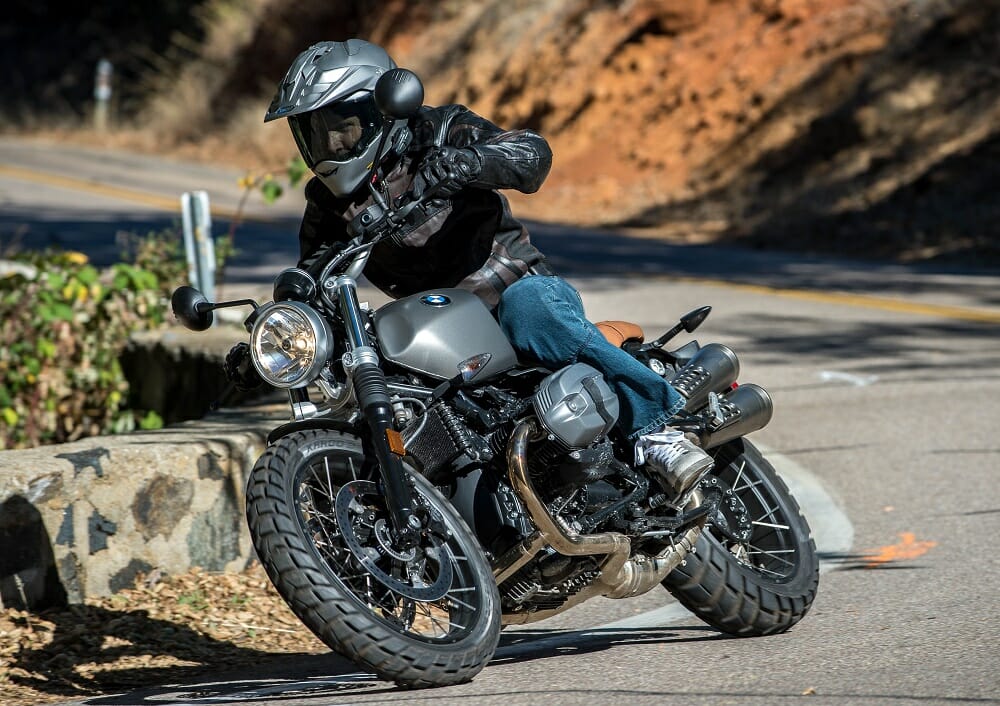 The combination of excellent ergonomics and that engine made the BMW the almost-winner.
The combination of excellent ergonomics and that engine made the BMW the almost-winner.
BMW had good genes from which to draw the R nineT Scrambler. The R nineT roadster is one of the company’s finest machines, so chopping it up into a scrambler variant only seemed the natural course of action. It’s not the same bike with knobby tires—the steering geometry is different, there’s larger wheels and the ride position is changed thanks to the superbly styled, flat leather seat.
The Beemer is the big daddy of the quartet. The only bike here with a capacity of over 1000cc, the Beemer has far more horsepower than any other bike, but, thanks to five years of development with the air/oil-cooled flat twin (this version debuted in the 2011 BMW R 1200 GS), it gets power to the ground smoothly with a minimum of fuss—very Germanic, shall we say.
You can feel the weight (it’s the second heaviest bike on test) and each tester complained about the vague front-end feel. This was something we noted in our First Ride back in October, but on smooth dirt roads and tarmac, this issue wasn’t as pronounced as the rougher roads encountered on the launch.
The engine is brilliant, the gearbox too, but the Beemer won more votes for its styling than anything else. The designers had plenty of inspiration to draw on when creating the bike because air-cooled boxers have been getting chopped into scramblers for years, and the men from Munich really did hit the aesthetic nail on the head.
The BMW also has more electronics than everything else (ABS, ASC, heated grips, no surprises there) and is probably the least likely to get chopped up/customized, simply because most of it is already done for you.
The BMW R nineT Scrambler is an excellent bike, but also a fair bit pricier than the rest. Here it lost points, and only just missed the overall win because the actual scrambling experience was better served on the Ducati. ~Rennie Scaysbrook
 (Left) The fit and finish on the R nineT Scrambler is superb, as it that leather seat. (Middle) Those fake Supertrapp-style exhausts sound the business. (Right) Welcome to 21st century scrambling, complete with the optional extra navigation.
(Left) The fit and finish on the R nineT Scrambler is superb, as it that leather seat. (Middle) Those fake Supertrapp-style exhausts sound the business. (Right) Welcome to 21st century scrambling, complete with the optional extra navigation.
Jesse Ziegler This bike the biggest, baddest and most eye-catching of the bunch — you can’t not be attracted to it. The opposing twin cylinders draw even more attention than the Guzzi’s upright outriggers and it’s got a shake and rumble that is undeniable old-school. Hell, it even smells like oil after a good flogging—I’ll take it! Clearly, the BMW is a style winner but it also performs pretty damn well. The front geometry is funky on the tarmac, feeling stretched out where most scramblers are more like compact street bikes with knobbies. It takes some getting used to on the street. I love the power delivery of the BMW boxer — it leaves knobbie-like trenches in dirt with reckless abandon. It’s a hoot on the street with passing power on tap and plenty of comfort from the seat and rider positioning. Plus it looks awesome – I grew a hipster beard just by looking at it in my garage!
Kit Palmer The BMW R nineT Scrambler is a looker. And I would consider owning one just for that reason alone. Luckily, the BMW has the performance to match. I enjoyed the Beemer’s strong engine and smooth power delivery, the suspension is solid and egos are well laid out, the only hitch in the BMW’s get-along is a strange-feeling front end. Lean it to the left and the front end feels like it wants to go to the right, and vice versa. It feels very odd at first but you do get used to it eventually. On the dirt, steering feels fine — the front end stays planted and the smooth power makes sliding fun and controllable, even though it’s the largest-feeling bike of the four. It’s also the best sounding with that Akrapovic exhaust system. Good job, BMW.
Sean Finley Regardless of cost, I would buy the BMW. It has the best motor, most comfortable riding position and looks really cool. The Akrapovic exhaust looks and sounds really cool, and compared to the Ducati and Moto Guzzi, the BMW feels a little bigger and more comfortable for extended riding. Some felt that the corning character of the BMW was a little vague in the front end on the pavement but I would not buy any of these bikes for ripping through the canyons. If I was looking for that type of bike, I’d get the standard R nineT. In the dirt, the BMW is at least as good as any of the other bikes and a little more stable at higher speeds.
First – Ducati Scrambler Icon
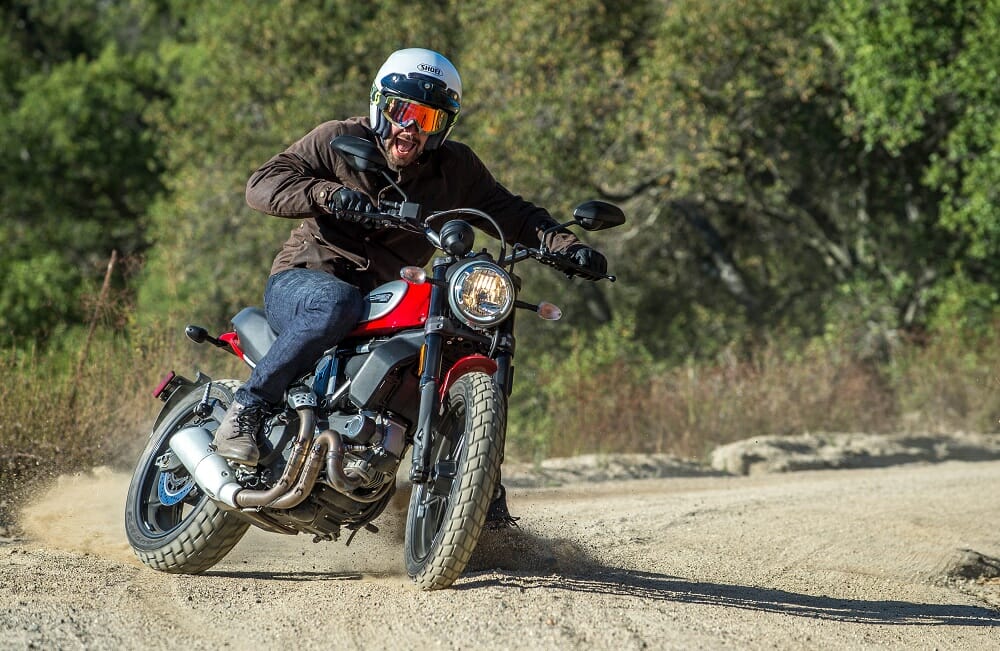 This kind of stuff is easy on the Ducati. The package wills it so!
This kind of stuff is easy on the Ducati. The package wills it so!
The Vitals – Ducati Scrambler Icon
|
Engine:
|
803cc, air/oil-cooled L-Twin, eight valve Desmodromic four-stroke
|
|
Chassis and suspension:
|
Tubular steel trellis frame, 41mm, inverted, unadjustable Kayaba forks, single preload-adjustable Kayaba shock.
|
|
Front brakes:
|
Single 330mm disc, radial four-piston caliper, ABS
|
|
Rear brakes:
|
245mm disc, single-piston floating caliper, ABS
|
|
Front/Rear wheel sizes:
|
18 inch/17 inch
|
|
Weight:
|
410 lbs. (wet, claimed)
|
|
Electronics:
|
ABS
|
|
MSRP:
|
$8,995
|
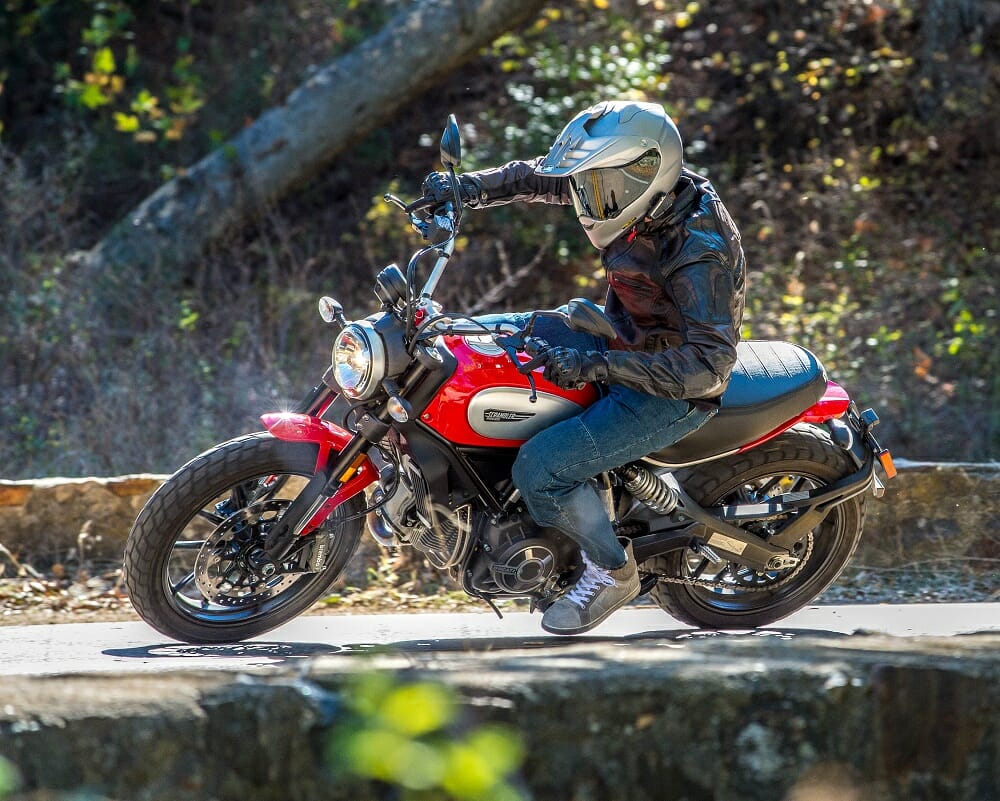 Despite not having very high-spec front suspension (come to think of it, no bike here does), the Ducati will still carve up canyons nicely.
Despite not having very high-spec front suspension (come to think of it, no bike here does), the Ducati will still carve up canyons nicely.
If you think about the modern scrambler, chances are the Ducati will be the first bike that springs to mind. Two years ago the crew from Bologna reinvented the segment, regardless of whether Triumph had a factory scrambler for 10 years prior or not. They made Ducati cool—as if that was ever a problem in the first place—and introduced the brand to a whole range of people that would have otherwise never have heard of it.
The Ducati was my pick of the bunch. For the price, you get a hell of a lot of bike—it’s got style for days, an easy to ride 803cc Desmo L-twin and of all the bikes here, this one makes me want to play around with it and customize the most.
Weight plays a big factor in the Ducati’s ranking—it carries its lack of girth extra well, and feels like a toy in the dirt. That’s exactly what scrambling is all about want, easy dirt riding with capable on-road manners. Predictability in the handling department was a big score for the Ducati, even if it lost out to all-round grunt of the BMW.
Ergonomically, the Ducati was fine for me but Kit found it a little cramped, as did Sean. I can’t for the life of me understand how that seat was allowed through to production, because there’s a hump two-thirds of the way to the front which forces your bits into the tank (or you have to sit way back near the passenger seat to get comfortable). Still, that’s an easy fix—a custom seat would be first on the list of upgrades should I have one in the garage.
It was extremely close to a dead heat between the Ducati and BMW for the win in this test, but, finally, we gave it to the Ducati because of less weight, a much lower price tag and better dirt capability. If all you wanted was road manners, the BMW would take the cake, but the overall package of the Ducati just pips the Munich men for the win. Just. ~Rennie Scaysbrook
 (Left) That seat was a let-down and a deal-breaker for some. (Middle) Bar bend is quite high with a few testers commenting they would bend quite easily in a tipover. (Right) Good brakes were another Ducati strong point.
(Left) That seat was a let-down and a deal-breaker for some. (Middle) Bar bend is quite high with a few testers commenting they would bend quite easily in a tipover. (Right) Good brakes were another Ducati strong point.
Jesse Ziegler The Ducati is the cool guy or gal’s scrambler—the one where you can say, “Yeah, it’s a really fun bike, plus it’s a Ducati.” And that’s what scramblers are really about—being a bit different than the rest and truly owning a look. I liked riding the Ducati a lot. It’s a good-looking bike that oozes legitimate cool. The only components not up-to-par are the ridiculous seating position and a somewhat silly looking swingarm. The drive is good from the 803cc L-twin, offering torquey grunt that doesn’t get out of control in the dust. It’s got good power for what these bikes are designed for. It doesn’t have the highway passing surge speed, but who gives a shit? This bike is for ripping paved corners and exploring fire roads and looking cool, and it does that extremely well.
Kit Palmer If you’re looking for bang-for-buck performance, the Ducati is the best bike. It’s got the suspension, the motor, the brakes, the technology, the looks, and the sound. Unfortunately for me, it doesn’t have the comfort. For my 6’1’’, the Ducati is a touch too cramped and the dip in the seat compounds the problem by making it nearly impossible to move around and stretch out, something I wanted to do shortly into my rides on the Ducati. An aftermarket seat would be a cure. Straight to the point: The Ducati is the all-around best-performing bike of these four. But, for me, when it comes to scrambling, it’s not all about performance.
Sean Finley With a roomier cockpit, the Ducati would be my first choice. It is a great bike overall that feels very refined, runs great, has good brakes and is the best bike in the group for carving corners on the pavement although the BMW has a much more impressive motor. The Ducati has an authentic Scrambler look as well. The seat to footpeg range is tight for my average 5’10” frame and the bike feels cramped. If you are used to riding sportbikes, it probably will not feel too cramped but for me a bike like this needs to be about comfort. For shorter riders, the short seat height would be great. In the dirt, the Ducati is also very predictable and the small feel adds to that, especially if you are standing up. It will allow for some fun slides on gravel roads and the predictable power provides confidence. CN